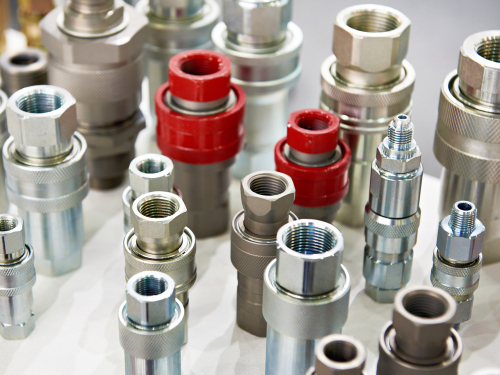Identifying Quick Hydraulic Couplers
Quick hydraulic couplers, also known as quick disconnect couplings or QRC, are fast-connecting fittings that create a fluid-tight seal to maintain pressure while allowing equipment changes in air and liquid transfer, tool assembly, diagnostics, and other tasks that require frequent swapping out of tools and machinery. They are available in a variety of types, materials and pressure ratings. Learn how to identify the quick disconnect you need for your application.
Types
When it comes to hydraulic connections, quick couplers are an excellent choice for applications that require frequent connection and disconnecting of fluid lines. Their easy switch on and off design can help reduce downtime during line changes, saving you time and money. Quick hydraulic couplers come in a variety of different types, each with its own unique characteristics. These include the body material, threads, valving mechanism, and seals.
Flat Face: ISO 16028 Interchange Couplings – Designed for applications requiring no leak performance, the mating surfaces of each half of the coupling are easily cleaned before connecting to minimize air and dirt ingression. This minimizes the amount of fluid that may escape during connection or disconnection, which is important for applications where costly or hazardous materials are conveyed.
Poppet: Ball/Poppet (cone) Type – Traditionally used in agricultural machinery, oil tools, and mobile construction equipment, these couplers use balls or poppets to block the flow of fluid exiting one end. They are rated to similar pressures as flat face couplings, and are commonly found on skid steer loaders.
Materials
When selecting a hydraulic quick coupler, material selection is an important consideration. Quick couplers are available in a variety of materials, including stainless steel, brass, and aluminum. Choosing the right material can depend on the fluids that are transported in the system and other factors, such as cost, flexibility, environmental conditions, and required pressure ratings. A few popular materials include carbon steel, stainless steel, and aluminum. They are commonly plated to resist corrosion and improve durability. Another common material used in quick disconnect couplings is polypropylene, which is strong and durable and can resist a wide range of chemicals and temperatures. This type of material can be molded to meet specific applications or shapes.
Pressure Ratings
The fluid that flows through the coupling is a key factor in selecting which type of coupler to use. For example, oil has a higher viscosity than air so it requires more pressure to flow through the coupling. In addition, fluids that are in contact with metals should be tested to determine whether they can handle the pressure that is associated with the material of the coupling. Hydraulic couplings can be rated to provide the highest possible pressure. The maximum pressure rating for a coupling depends on its design and can be increased or decreased as needed to meet the needs of a particular application.

Applications
Hydraulic couplers are particularly useful in assembly workstations where workers need to switch between tools in seconds. Without them, it would take much longer to switch out each tool and air line. Similarly, tractor operators use them to quickly change out attachments such as grapplers and tree shearers. They also help reduce testing time on hydraulic test stands. Both flat face and poppet types of hydraulic quick couplings are widely used for construction equipment, forestry equipment, and agricultural machinery. While flat face couplings feature a check valve style system, poppet types feature balls or poppets that push against each other when connected.

